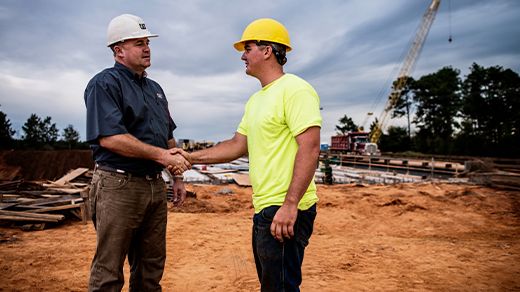

Sign In
Welcome! Sign In to personalize your Cat.com experience
If you already have an existing account with another Cat App, you can use the same account to sign in here
Register Now
One Account. All of Cat.
Your Caterpillar account is the single account you use to log in to select services and applications we offer. Shop for parts and machines online, manage your fleet, go mobile, and more.
Account Information
Site Settings
Security
Your business can choose from a wide range of financial solutions and special offers to ensure you get the most value.
However, first, you have to make some key decisions, like:
What is your equipment financing budget?
Do you want to lease or purchase the equipment?
Building a budget
Building a budget can mean determining two different things: How much you are willing to spend on a monthly payment, and how much you can spend on a down payment if necessary.
A down payment is typically only necessary if you plan to take out a loan to purchase the equipment. This can be a large upfront cost, but it might be a wise investment. If your company needs a piece of equipment for a long-term construction project, or if the equipment is necessary for many different types of projects, it may be smarter to get a loan.
That being said, leasing equipment can be a smart option when equipment is only needed for a short period of time. It could also be a wise idea even for equipment needed for long-term use, because then you don’t have to worry about the equipment getting old and decreasing in value. Plus, similar to renting equipment, leasing can give you the opportunity to try out the latest equipment technology available in newer models before you choose to purchase a machine.
There are many options available for equipment financing, and Cat Financial can help you decide what’s best for your unique needs and budget.
Understanding your options
We know that all businesses have different goals. That’s why our equipment loans and leases come with multiple options You should review all your options and choose the ones that suit your financial plan.
Finance lease
A finance lease is a great option if you are unsure what your long-term needs are for a piece of equipment. There is no initial down payment, and at the end of your lease, you have the option to buy the equipment, return it or extend the lease further.
With a finance lease, the equipment is treated as though it is effectively owned by your company.
While, technically, you are leasing it, you will still be considered the owner when it comes to taxes and accounting. This provides both financial liabilities and benefits. For example, you must account for depreciation and interest expenses on your financial statements, but you also may be eligible for tax benefits by owning the equipment.
Operating lease
Similar to a finance lease, an operating lease comes with the option to return, lease or buy the equipment at the end of the contract. However, this plan offers the lowest possible monthly payments, while Cat Financial remains the owners of the equipment. This provides the most flexibility, but it may not be the best financial decision for equipment you are going to need long term.
Equipment Protection Plans
If you choose to purchase a machine by leveraging an equipment loan, your equipment comes with a great standard warranty. If you want coverage after your standard machine warranty expires, you can contact your local Cat® dealer to discuss the multiple coverage levels available to you in an Equipment Protection Plan (EPP). This option protects your equipment for a longer period of time, which could be a smart move if you see unplanned repair costs as a strong possibility. Want to learn more about Equipment Protection Plans? Check out these 5 Reasons to Protect Your Cat Equipment with EPP.
Insurance
Insurance options like Physical Damage Insurance and Commercial General Liability Insurance from Cat Financial are another way to protect your equipment and your business from the unexpected. It adds a monthly fee to your budget, but it ensures that you never lose out on your investment. For contractors, certain insurance is often required when you acquire machines for a job, so it’s important to know your options. View insurance options
Customer value agreements
A customer value agreement (CVA) is an ownership plan that helps you get the most out of your equipment. CVAs are tailored to your goals and needs, so you can finance your equipment in a way that works with your budget.
With a Customer Value Agreement, you decide whether you want to do your want to perform maintenance yourself or opt for dealer service. Additionally, CVAs come with an Equipment Protection Plan (EPP), and you can choose your level of coverage. You can use a CVA to maximize the value of your investment.
Why Cat Financial
We have a wide range of equipment financing options that are flexible and tailored to your needs. Not only that, but our special offers could make it easier for your business to get the Cat equipment your next job depends on.
Additionally, you can manage your account with MyCatFinancial, making it more convenient to pay bills, check your interest paid and remaining principle, calculate early payoff scenarios, print contacts, sign documents and more from the office or on the job site.
Our online management system helps you keep track of your equipment financing so you can make the smartest decisions possible. If you do not already have an account, you should register for one today.
At Cat Financial, we pride ourselves on making it easier for you to get the equipment you need for success while staying within your budget. Contact us today for more information.
Additional Articles
Find in-depth articles to answer your questions about construction equipment financing, and expert tips to help you navigate today's economy as a successful business.




